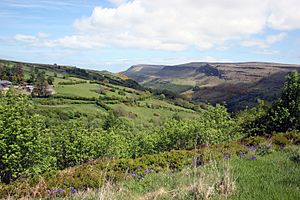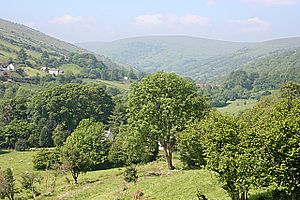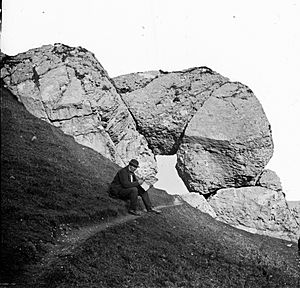Glens of Antrim facts for kids
The Glens of Antrim, often called just The Glens, is a special area in County Antrim, Northern Ireland. It's made up of nine amazing glens, which are long, deep valleys. These valleys stretch from the high Antrim Plateau down to the coast. The Glens are known for their incredible natural beauty and are a very popular place for tourists to visit in north Antrim.
The main towns and villages you'll find in the Glens include Ballycastle, Cushendun, Cushendall, Waterfoot, Carnlough, and Glenarm.
Discovering the Nine Glens
There are nine main glens, each with its own unique charm. They are listed here from north to south:
| Glen Name | Irish Name | Meaning |
|---|---|---|
| Glentaisie | Gleann Taise | Taise's valley or damp valley |
| Glenshesk | Gleann Seisc | Barren valley |
| Glendun | Gleann Doinne | Valley of the [river] Dun |
| Glencorp | Gleann Corp | Valley of the body (or bodies) |
| Glenaan | Gleann Athain | Valley of the burial chamber |
| Glenballyeamon | Gleann Bhaile Uí Dhíomáin Gleann Bhaile Éamainn |
Valley of Ó Díomáin's town Valley of Éamonn's town |
| Glenariff | Gleann Aireamh | Valley of the ploughman or arable valley |
| Glencloy | Gleann Claidheamh | Valley of the sword |
| Glenarm | Gleann Arma | Valley of the army |
Is There a Tenth Glen?
Sometimes, people also include Glenravel as a tenth glen. It's located to the southwest of Glenballyeamon and Glenariff. The Glenariff forest park separates it from Glenariff.
The main places to live in Glenravel are Cargan, Martinstown, and Skerry (also known as Newtowncrommelin).
Ancient History of the Glens
The Glens of Antrim have a very long history, with signs of people living there since the Neolithic period, also known as the New Stone Age. This was a time when people started farming and using more advanced stone tools.
At a place called Glencloy, Stone Age people built large stone tombs, called megalithic tombs, in the uplands. They likely lived in settlements closer to the coast at the end of the valley. The beaches were important because they provided flint, a type of stone used to make tools. Archaeologists have found many sites where these stone tools were made.
Near Glenarm, at a spot called Madman's Window, experts discovered areas where Neolithic people chipped and shaped stones to make tools. They found rough shapes of stone axes, along with pottery, scrapers, flakes, and arrowheads shaped like leaves.
Another important Stone Age site is Bay Farm in Carnlough, which was near marshland. Here, archaeologists found evidence of people living there, including charcoal from fires, holes where wooden posts once stood, flint cores (the leftover stone after tools were made), axes, and Neolithic pottery. These discoveries help us understand how ancient people lived in the Glens.




